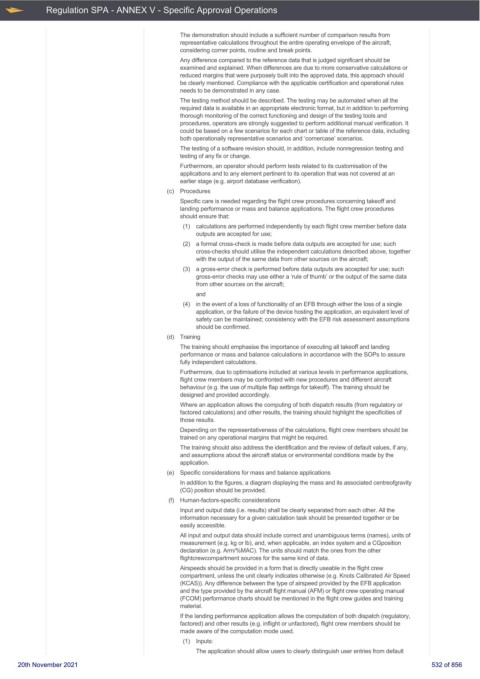Page 532 - UK Air Operations Regulations (Consolidated) 201121
P. 532
~
~ Regulation SPA - ANNEX V - Specific Approval Operations Centrik
The demonstration should include a sufficient number of comparison results from
representative calculations throughout the entire operating envelope of the aircraft,
considering corner points, routine and break points.
Any difference compared to the reference data that is judged significant should be
examined and explained. When differences are due to more conservative calculations or
reduced margins that were purposely built into the approved data, this approach should
be clearly mentioned. Compliance with the applicable certification and operational rules
needs to be demonstrated in any case.
The testing method should be described. The testing may be automated when all the
required data is available in an appropriate electronic format, but in addition to performing
thorough monitoring of the correct functioning and design of the testing tools and
procedures, operators are strongly suggested to perform additional manual verification. It
could be based on a few scenarios for each chart or table of the reference data, including
both operationally representative scenarios and ‘cornercase’ scenarios.
The testing of a software revision should, in addition, include nonregression testing and
testing of any fix or change.
Furthermore, an operator should perform tests related to its customisation of the
applications and to any element pertinent to its operation that was not covered at an
earlier stage (e.g. airport database verification).
(c) Procedures
Specific care is needed regarding the flight crew procedures concerning takeoff and
landing performance or mass and balance applications. The flight crew procedures
should ensure that:
(1) calculations are performed independently by each flight crew member before data
outputs are accepted for use;
(2) a formal cross-check is made before data outputs are accepted for use; such
cross-checks should utilise the independent calculations described above, together
with the output of the same data from other sources on the aircraft;
(3) a gross-error check is performed before data outputs are accepted for use; such
gross-error checks may use either a ‘rule of thumb’ or the output of the same data
from other sources on the aircraft;
and
(4) in the event of a loss of functionality of an EFB through either the loss of a single
application, or the failure of the device hosting the application, an equivalent level of
safety can be maintained; consistency with the EFB risk assessment assumptions
should be confirmed.
(d) Training
The training should emphasise the importance of executing all takeoff and landing
performance or mass and balance calculations in accordance with the SOPs to assure
fully independent calculations.
Furthermore, due to optimisations included at various levels in performance applications,
flight crew members may be confronted with new procedures and different aircraft
behaviour (e.g. the use of multiple flap settings for takeoff). The training should be
designed and provided accordingly.
Where an application allows the computing of both dispatch results (from regulatory or
factored calculations) and other results, the training should highlight the specificities of
those results.
Depending on the representativeness of the calculations, flight crew members should be
trained on any operational margins that might be required.
The training should also address the identification and the review of default values, if any,
and assumptions about the aircraft status or environmental conditions made by the
application.
(e) Specific considerations for mass and balance applications
In addition to the figures, a diagram displaying the mass and its associated centreofgravity
(CG) position should be provided.
(f) Human-factors-specific considerations
Input and output data (i.e. results) shall be clearly separated from each other. All the
information necessary for a given calculation task should be presented together or be
easily accessible.
All input and output data should include correct and unambiguous terms (names), units of
measurement (e.g. kg or lb), and, when applicable, an index system and a CGposition
declaration (e.g. Arm/%MAC). The units should match the ones from the other
flightcrewcompartment sources for the same kind of data.
Airspeeds should be provided in a form that is directly useable in the flight crew
compartment, unless the unit clearly indicates otherwise (e.g. Knots Calibrated Air Speed
(KCAS)). Any difference between the type of airspeed provided by the EFB application
and the type provided by the aircraft flight manual (AFM) or flight crew operating manual
(FCOM) performance charts should be mentioned in the flight crew guides and training
material.
If the landing performance application allows the computation of both dispatch (regulatory,
factored) and other results (e.g. inflight or unfactored), flight crew members should be
made aware of the computation mode used.
(1) Inputs:
The application should allow users to clearly distinguish user entries from default
20th November 2021 532 of 856

